It’s Easy to Think . . .
. . . that the work is always easy for me as Paul Sellers. It’s not, not at all. The flow seems fine in the reviews I check before videos go out, but getting there takes structure through planning, micro- and macro-adjustment, attitude changes and other such things too many to list.
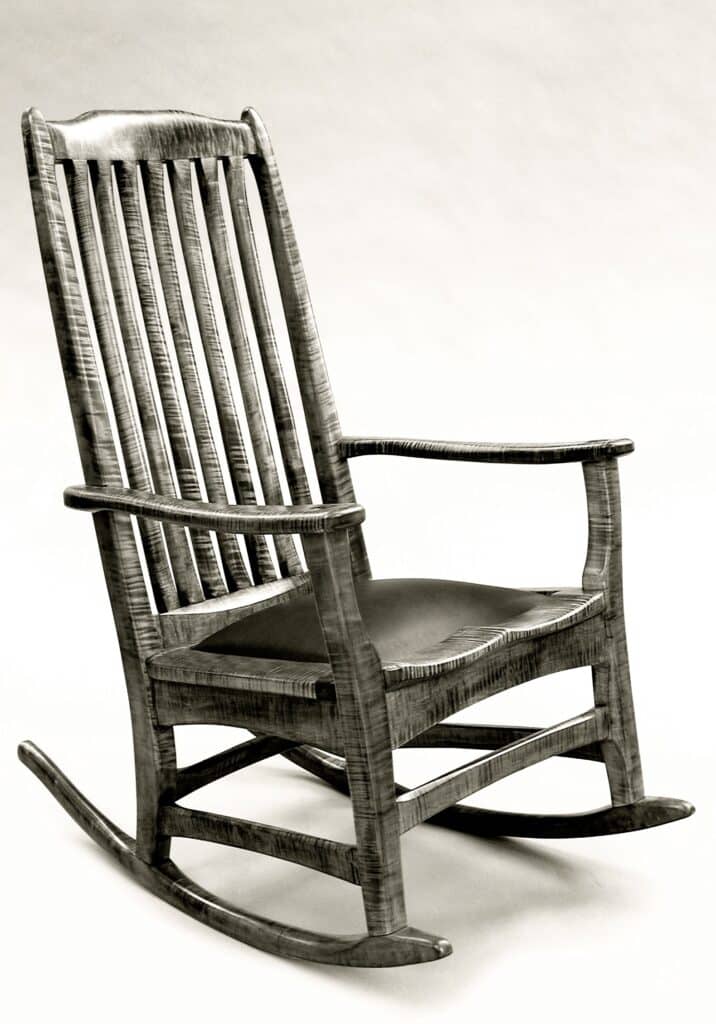
In the making of many things, I think I have run the gamut and perhaps more than most – certainly, more than most in my making using only hand tools over the decades. I have thousands of pieces under my belt. From spiral stairways to massive shop and bank doors to small boxes of any and every kind, birdhouses and bunk beds, dining tables aplenty and then the chairs to match. Designing pieces for others to make in the plurality of cabinet makers working alongside me was my norm in times past. I designed chairs I never made alongside cabinets spanning many meters long. I made drawings to work to and passed my ideas along through the drawings they made to. I went from houses to offices to store interiors to remake them for a more up-to-date look and ruined the soles of planes and saws working plastic laminate into twists and turns to create the right flow. You would think confidence would build in immeasurable amounts and in some ways it does but then there is something of real value in not being so completely confident that you lose the edge a lack gives you. I learned this in my younger days of climbing severe and extreme climbs on different rock faces. The grades of climbs change according to different conditions. What might be easy enough up to 30 feet off the ground changes dramatically when the height-gain changes to 200. It’s the exposure you see. I didn’t do any technical climbing with much-sophisticated equipment. I free-climbed mostly and then too mostly on my own. It was hard in those days to find others to partner with.
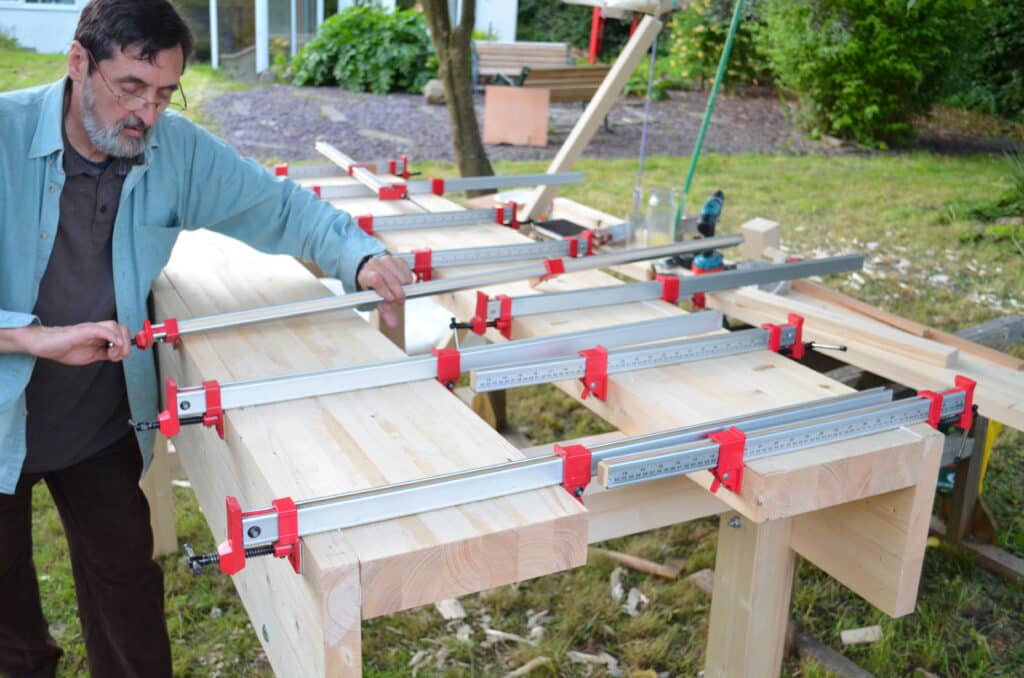
This morning and over the last few days I have considered my work and the impressions given as I review the videos. Mostly, I am looking for silly bloopers like calling a dovetail a mortise or a millimetre a centimetre, oak walnut, things like that. It doesn’t happen too much but they are there and sometimes they cannot be edited out. Other issues might be a poor safety choice: not wearing a mask is an instance or cutting towards my hand with something sharp. In actuality, I often wear a mask when I really don’t need to but it appears careless though it is not. Because our extraction is so good our very sophisticated measuring device with which we check air quality doesn’t even pick up significant change after using the bandsaw and such for a prolonged period. I still try to wear a mask though, to encourage everyone to wear one for their own wellbeing and safety. With cuts towards my body. Often these are again appearance only rather than any kind of danger. Lens warp distorted reality by making things look much closer than they actually are. It’s best not to have even the appearance of some issue rather than risk others copying what could be dangerous to them. These are the things we might edit rather than give the impression that this or that practice is acceptable.
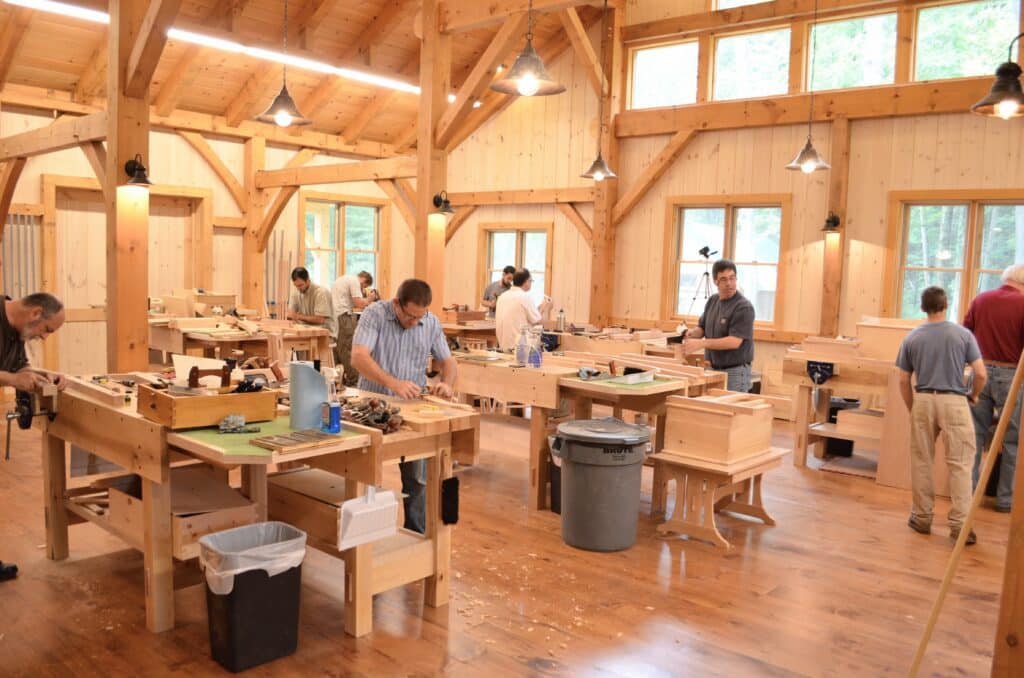
When I design things large or small there is an excitement that comes from the as-yet unknown outcome. I recently made some wooden combs. It seemed a silly thing to want to do but I wanted to see how I could design the making process itself and then make them well enough as a saleable item at an affordable price. I thought that the price should come in at around £25 per comb. It was more an experiment but I realised partway through that they were indeed saleable and the variability could cater to a variety of hair types and comb types too. I got the production down to two combs complete in about an hour and less if I made in batches of ten. I am trying to design things that can be made for others to make and make a living from making them. I have about five designs designed to that end.
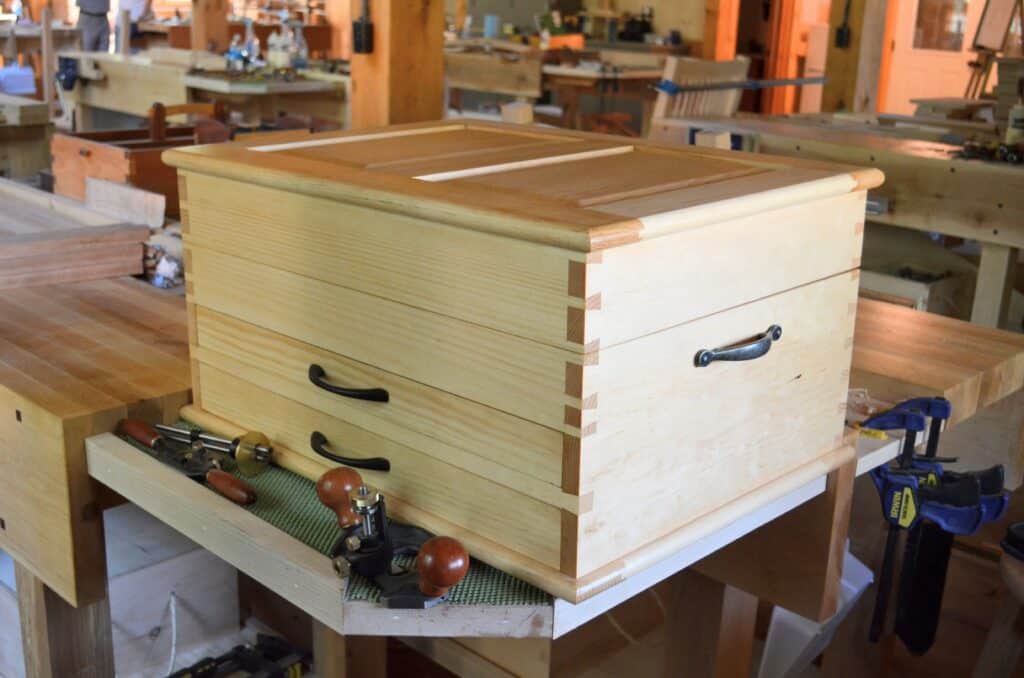
The last ten years of changed direction did not change my making life and lifestyle but added to it with filming and that changed the dynamic of making in many ways for me as well as for others. Entering the world of the USA to both live and work there ushered me into the world of machinist woodworking but almost all of the machinists I met were enthralled by my ability to do what they did with machine-only methods by primarily hand methods using the hand tools they knew very little of. It gradually unfolded, but I rose to the challenge to try to change what I saw as a one-man quest at that time and alone in Texas, the state that could engulf my native Britain almost three times or take ten European countries with room to spare. Though it began there in Texas with its population of 30 million I now reach around that many in a year online and all of those that follow follow because they like the concept of making by hand with hand tools.

In those early days of the mid-1980s, I felt quite alone. Woodworking shows showed no signs of hand tools except for salesmen selling specialist hand tools and support equipment like sharpening equipment and guides of different kinds that were going to redefine your hand skills. of course, they didn’t. Skill does not come to us that way. Skill comes by practice coupled with the determination not to give up. The end result was starting two schools that taught hand skills one to one, but that is history for me now. The most important thing was the stepping stones these schools provided for me to reach woodworkers around the world. `the first school equipped and enabled me to start writing the curriculum for hand tool woodworkers to learn from and this prefaced my creating online content in different disciplines including my videos through which I chiefly teach. That is how I reached most of you. What you now take for granted came at great cost to me. but I did not want to leave this earth without leaving a legacy. My writings form the basis of my early intent and I find my success wonderfully measured in the planting of seeds in the human heart.
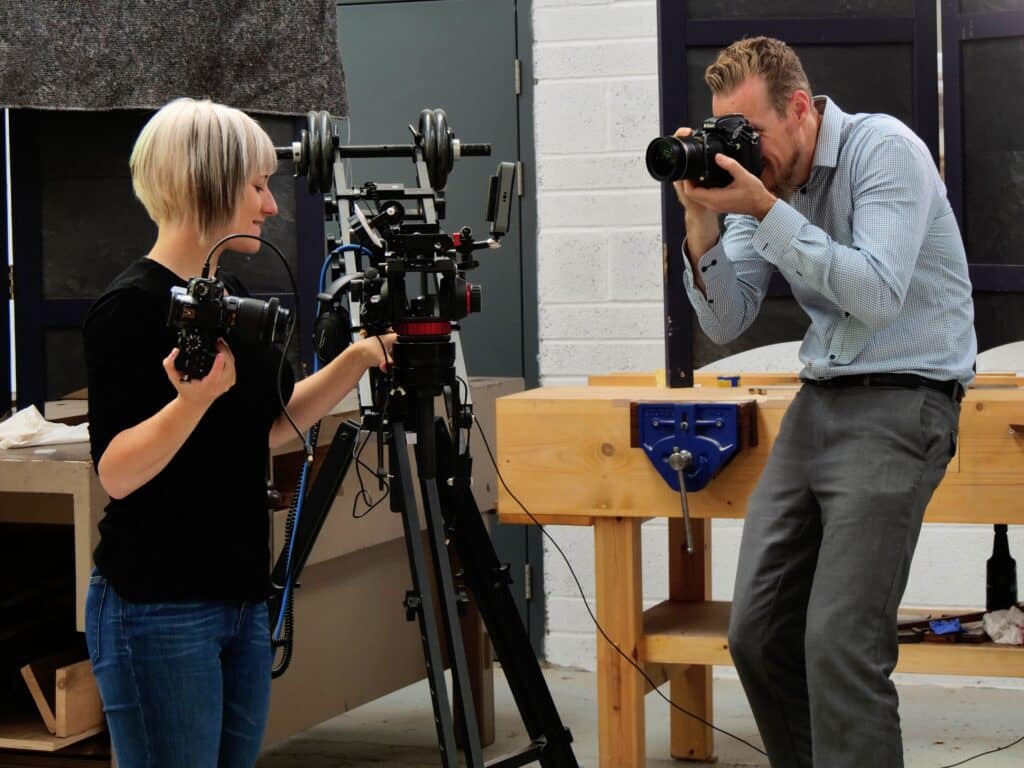
Remember my video series building the workbench in my back garden in North Wales? I had already filmed a wide range of hand-made hand tool project videos to accompany my first book back in the day with a film company. This new filming was indeed a new venture and an adventure that cost us in many ways we never really expected. Joseph was behind the camera and I didn’t have a clue. We were using two inexpensive camcorders. But what surprised me was how much influence the filming played on my work. It made me realise how experiments have an influence on the outcome. I did not want to play to the lens like an actor or an anchor person in their artificiality and unrealness. I wanted the realness of honest handwork relying on skills that would inspire others into my world of real woodworking.
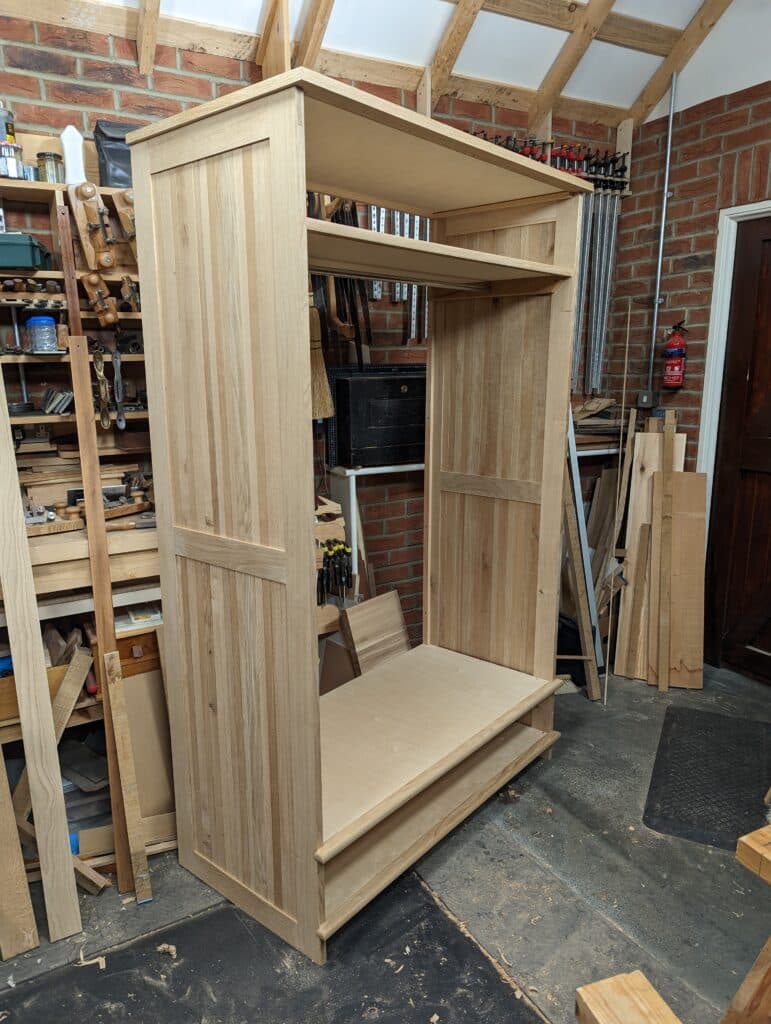
As I settle at my workbench each morning I’m influenced by you. I am thinking about the work ahead before the cameras start rolling and I am considering the steps I must take to bring clarity from your side of the lens. Of course, when the videographers come in they might determine additional tweaks to get the lens into an exact position without interfering with my working functionality in the cutting and fitting of wood to wood. In some ways, and even with the best intentions, this then translates inevitably into making what I see what you need to see but usually the lens is exactly opposing. I must sometimes twist and turn into unnatural positions so that a camera points over my shoulder or my actions become so obvious that they cannot be misinterpreted. At this point, I often stop to describe what I can see, what I am actioning and what I might expect to take place but cannot possibly be seen. This then is what I never had to contend with in my former life isolated as a lone maker working in my castle.

But there are pockets where and when no one comes near throughout the day or week. Times for me to make and experiment is what I have done throughout my decades as a maker and designer. Here my domain is established and I can keep an excess of everything out on my bench be that tools, wood, shavings and recording notebooks and journals as and if I want to. I think sometimes this infuriating positioning is my favourite and the next favourite is picking up and putting up to regain space. This is what you cannot see or feel or know that I enjoy.
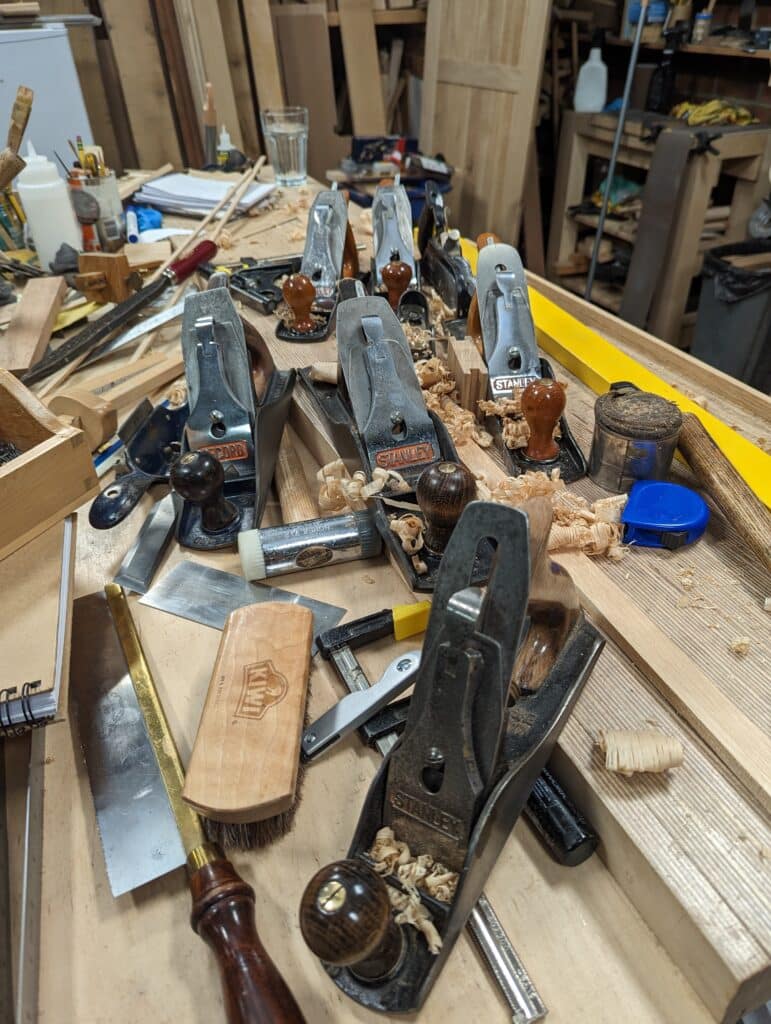
So the search for answers changed my workshop and practices in ways the majority may never need or know. It took a paradigm shift for me to engage the changes needed but I have enjoyed these changes very much and thinking through how I can present what I know, though no less challenging than making a new and unknown design still captivates me in the most unexpected ways.
I just thought you should know that it is not always easy and rarely an easy choice but once I have done it I usually feel, well, enthralled!



Lovely wardrobe! I always enjoy these first look posts.
Paul
I was just curious as to the use(s) of the Kiwi shoe polishing brush. Thanks for all.
Gerry
We’ve seen him brush pieces with it after applying wax to them with steel wool
I think you should know that on THIS side of the camera are many who are also enthralled. Thanks for all that you do.
When will the Brazos Chair book come out?
Hello Ermir. Well, I think I have three important books in manuscript form and in my head or on scraps of paper I want to pull together but I feel time is running out. I can’t say that this is a priority but I would like to do it just for Texas and Texans alone.
Dear Paul
I continue to be amazed at your work schedule and range of amazing projects.
I am privileged to use a number of the simpler projects with my home schooled lads and lass at Skillway in Godalming Surrey.
It was such a joy this year to help 4 lads make your excellent hand router, turned wooden handles the lot as well as the making of the metalwork pieces in the metal department.
At 75 I am still learning from your excellent videos.
Many many thanks.
At the risk of appearing morbid or giving offence: you say “… I feel time is running out”. So do I (more for me than you), what about a “Build your own coffin” item? I guess lots of amateur craftsmen would like to do this, either for themselves or loved ones, and it could save the family a few bob.
I also think perhaps developing a “little things one can make to give” stream would be lovely. My granddaughter (7) hand sewed me a cotton handkerchief from 4 bits of gingham for Christmas and equivalent projects for young kids (to do with doting (grand)fathers) would be wonderful. If you had young people demonstrating as role models so they can see they can cut a joint the call to the youth would be further promoted. It might have gaps in the joints and not be as beautiful as your work, but tall oaks from little acorns grow and as you said, it takes years.
Running out of time can mean different things. Going off how I feel now I do not mean getting old so much perhaps being crowded out. The competition for ‘airspace’ and the ensuing of artificial intelligence, CNC equipment and the inevitable and unstoppable ’embracement’ of every kind of technological substitute for human input designed to replace the human spirit is self evident. I am becoming the needle in the haystack. Trying to find true teaching and training and the real artisanse depends more now on what you wear, own and ar sponsored by. That’s one side of the buriel taking place. And then there are technology changes creating complexities we never though possible. By this I mean that my days may be numbered and not merely by the aging process. Just as machine woodworking has almost utterley subsumed hand work and the hand tooling of wood, so too I suspect will other technologies render everything we currently do with our hands be rendered obsolete and redundant. In my age range it may seem less relevant but to those yet to emerge, I think quite prevalent. This may be daunting to my generation or to me as a now aging artisan but I recall a day walking across a field in Texas 1987 or so and a man asking me if I had, “…ever heard of this new thing called the worldwide web.” I answered, “No.” He said, “Well, they say that shops will disappear and everyone will be buying through this worldwide web.” I said, I don’t think that can happen.” I don’t know where everyone else lives but we have seven or more Turkish barber shops, eqch with half a dozen barbers in them, tatoo parlours aplenty, more hairdressers than you can shake a stick at and goodness knows how many secondhand shops in the form of what’s called here charity shops. Try buying a tap washer if you will. How is it possible to buy half a dozen tap washers made in and shipped from China and take delivery for £3.50 with free shipping in under five days. As Bob Dylan sang (or lamented), “For the times they are a changin'” Who’d have thought a hundred adult men and women would stand, sit, run and a million more endeavours staring into a flat screen 3″ by 5″ for the majority of time in any given day.
Oh, and making a pine box for buriel. Yes, I have made few for friends. Dovetailed the corners, lined them beautifully and such. Such a box can look as nice just held together with a few dozen neat and well placed brad nails well punched and filled with wood putty. Not too much to it really.
codswollop! your work will last forever and always draw real woodworkers to work like John Henry against the rise of the machines. people love quality and realness. that NEVER will be replaced merely supplemented. Through your legacy the world has a precious gift of the real and the true. everything else, the slick magazines and boutique apparati come out of the northbound end of a southbound bull. and it smells the same! All hail WWMC! king paul the 1st!
1987?? 1997 (or 1994)?
I’m never to sure why a man would do something like this. What on earth does it mean to pose, “1987?? 1997 (or 1994)?”
If you are asking when the question was posed it was indeed up for discussion in the later 1980s and published in scientific papers of the age. Tim Berners-Lee, a British scientist, invented the World Wide Web (WWW) launched in 1989 and the Web was originally conceived and developed to meet the demand for automated information-sharing between scientists in universities and institutes around the world.
Such an interesting article, Paul. Inspirational as usual. I have developed a love for woodworking quite late in life, partly through making violins at classes in Cambridge, UK but also other items from YouTube. Your videos and blogs always give me such drive to try something new. Long may they continue!
I’m so relieved seeing how things stacks up on yuor workbench too..
But are we comparing apples for apples. I allow this for a short time and then I replace everything. Some people comment in the same way and with a few probing questions tell me theirs is similar all day, week and year. Mine is for no more than 30 minutes so how does that now compare?
I really appreciate these “philosophical” posts of yours. Getting your inside thoughts and beliefs help me relate my own work and thoughts. I remember meeting you 10+ years ago at one of the Woodworking Shows in the US. Didn’t realize at the time how influential you were and would become. Love your book and the work you do. What a legacy!
A very informative post. Thanks for that